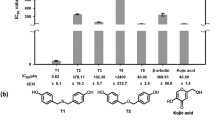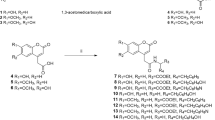Abstract
We synthesized (Z)-5-(2,4-dihydroxybenzylidene)thiazolidine-2,4-dione (MHY498) as a potential tyrosinase inhibitor. MHY498 potently inhibited mushroom tyrosinase activity (mean IC50 = 3.55 μM) in a dose-dependent manner. MHY498 was more potent than the well-known tyrosinase inhibitor, kojic acid (mean IC50 = 22.79 μM). When tested in B16F10 melanoma cells treated with α-melanocyte stimulating hormone (α-MSH), MHY498 inhibited murine tyrosinase activity and decreased melanin production without inducing cytotoxicity. Docking models showed that the binding affinity of MHY498 to tyrosinase was higher than that of kojic acid, and docking simulation results indicated that the tyrosinase binding moieties of MHY498 and kojic acid were similar. Western blotting showed that tyrosinase inhibition by MHY498 partly resulted from the expressional modulations of tyrosinase and its transcription factor, microphthalmia-associated transcription factor, via the cAMP–PKA–CREB pathway. These findings suggest that MHY498 could be useful as an antimelanogenic agent for the prevention and treatment of diseases associated with skin pigmentation.









Similar content being viewed by others
References
Bertolotto, C., P. Abbe, T. Hemesath, K. Bille, D.E. Fisher, J.P. Ortonne, and R. Ballotti. 1998. Microphthalmia gene product as a signal transducer in cAMP-induced differentiation of melanocytes. Journal of Cell Biology 142: 827–835.
Bilodeau, M.L., J.D. Greulich, R.L. Hullinger, C. Bertolotto, R. Ballotti, and O.M. Andrisani. 2001. BMP-2 stimulates tyrosinase gene expression and melanogenesis in differentiated melanocytes. Pigment Cell Research 14: 328–336.
Brenner, M., and V.J. Hearing. 2008. The protective role of melanin against UV damage inhuman skin. Photochemistry and Photobiology 84: 539–549.
Busca, R., and R. Ballotti. 2000. Cyclic AMP a key messenger in the regulation of skin pigmentation. Pigment Cell Research 13: 60–69.
Cabanes, J., S. Chazarra, and F. Garcia-Carmona. 1994. Kojic acid, a cosmetic skin whitening agent, is a slow-binding inhibitor of catecholase activity of tyrosinase. Journal of Pharmacy and Pharmacology 46: 982–985.
Cacic, M., and M. Molnar. 2011. Design, synthesis and characterization of some novel 3-coumarinyl-5-aryliden-1,3-thiazolidine-2,4-diones and their antioxidant activity. Zeitschrift für Naturforschung 66: 177–183.
Choi, H., S. Ahn, B.G. Lee, I. Chang, and J.S. Hwang. 2005. Inhibition of skin pigmentation by an extract of Lepidium apetalum and its possible implication in IL-6 mediated signaling. Pigment Cell Research 18: 439–446.
Chung, K.W., Y.J. Park, Y.J. Choi, M.H. Park, Y.M. Ha, Y. Uehara, J.H. Yoon, P.S. Chun, H.R. Moon, and H.Y. Chung. 2012. Evaluation of in vitro and in vivo anti-melanogenic activity of a newly synthesized strong tyrosinase inhibitor (E)-3-(2,4-dihydroxybenzylidene)pyrrolidine-2,5-dione (3-DBP). Biochimica et Biophysica Acta 1820: 962–969.
Ebanks, J.P., R.R. Wickett, and R.E. Boissy. 2009. Mechanisms regulating skin pigmentation: the rise and fall of complexion coloration. International Journal of Molecular Sciences 10: 4066–4087.
Fitzpatrick, T.B. 1971. The biology of pigmentation. Birth Defects Orig Artic Ser 7: 5–12.
Garcia, A., and J.E. Fulton Jr. 1996. The combination of glycolic acid and hydroquinone or kojic acid for the treatment of melasma and related conditions. Dermatologic Surgery 22: 443–447.
Gasperini, S., L. Crepaldi, F. Calzetti, L. Gatto, C. Berlato, F. Bazzoni, A. Yoshimura, and M.A. Cassatella. 2002. Interleukin-10 and cAMP-elevating agents cooperate to induce suppressor of cytokine signaling-3 via a protein kinase A-independent signal. European Cytokine Network 13: 47–53.
Ha, Y.M., J.A. Kim, Y.J. Park, D.E. Park, Y.J. Choi, J.M. Kim, K.W. Chung, Y.K. Han, J.Y. Park, J.Y. Lee, H.R. Moon, and H.Y. Chung. 2011a. Synthesis and biological activity of hydroxybenzylidenyl pyrrolidine-2,5-dione derivatives as new potent inhibitors of tyrosinase. MedChemComm 2: 542–549.
Ha, Y.M., J.A. Kim, Y.J. Park, D.E. Park, J.M. Kim, K.W. Chung, E.K. Lee, J.Y. Park, J.Y. Lee, H.J. Lee, J.H. Yoon, H.R. Moon, and H.Y. Chung. 2011b. Analogs of 5-(substituted benzylidene)hydantoin as inhibitors of tyrosinase and melanin formation. Biochimica et Biophysica Acta 1810: 612–619.
Ha, Y.M., J.Y. Park, Y.J. Park, D.E. Park, Y.J. Choi, J.M. Kim, E.K. Lee, Y.K. Han, J.A. Kim, J.Y. Lee, H.R. Moon, and H.Y. Chung. 2011c. Synthesis and biological activity of hydroxy substituted phenyl-benzo[d]thiazole analogues for antityrosinase activity in B16 cells. Bioorganic and Medicinal Chemistry Letters 21: 2445–2449.
Ha, Y.M., Y.J. Park, J.A. Kim, D.E. Park, J.Y. Park, H.J. Lee, J.Y. Lee, H.R. Moon, and H.Y. Chung. 2012a. Design and synthesis of 5-(substituted benzylidene)thiazolidine-2,4-dione derivatives as novel tyrosinase inhibitors. European Journal of Medicinal Chemistry 49: 245–252.
Ha, Y.M., Y.J. Park, J.Y. Lee, D.E. Park, Y.J. Choi, E.K. Lee, J.M. Kim, J.A. Kim, J.Y. Park, H.J. Lee, H.R. Moon, and H.Y. Chung. 2012b. Design, synthesis and biological evaluation of 2-(substituted phenyl)thiazolidine-4-carboxylic acid derivatives as novel tyrosinase inhibitors. Biochimie 94: 533–540.
Han, Y.K., Y.J. Park, Y.M. Ha, D. Park, J.Y. Lee, N. Lee, J.H. Yoon, H.R. Moon, and H.Y. Chung. 2012. Characterization of a novel tyrosinase inhibitor, (2RS,4R)-2-(2,4-dihydroxyphenyl)thiazolidine-4-carboxylic acid (MHY384). Biochimica et Biophysica Acta 1820: 542–549.
Hermanns, J.F., L. Petit, C. Pierard-Franchimont, P. Paquet, and G.E. Pierard. 2002. Assessment of topical hypopigmenting agents on solar lentigines of Asian women. Dermatology 204: 281–286.
Im, S., J. Kim, W.Y. On, and W.H. Kang. 2002. Increased expression of alpha-melanocyte stimulating hormone in the lesional skin of melasma. British Journal of Dermatology 46: 165–167.
Jiang, H., J. Ding, H. Li, H. Xie, X. Liu, L. Tong, and Y. Xu. 2011. Use of 5-substituted-2,4-thiazolidinediones in preparation of medicaments for modulating insulin-like growth factor 1 receptor. PCT International Applications.
Jones, K., J. Hughes, M. Hong, Q. Jia, and S. Orndorff. 2002. Modulation of melanogenesis by aloesin: a competitive inhibitor of tyrosinase. Pigment Cell Research 15: 335–340.
Kameyama, K., C. Sakai, S. Kondoh, K. Yonemoto, S. Nishiyama, Tagawa, M. Murata, T. Ohnuma, T.J. Quigley, A. Dorsky, D. Bucks, and K. Blanock. 1996. Inhibitory effect of magnesium l-ascorbyl-2-phosphate (VC-PMG) on melanogenesis in vitro and in vivo. Journal of the American Academy of Dermatology 34: 29–33.
Kim, Y.J., J.K. No, J.S. Lee, M.S. Kim, and H.Y. Chung. 2006. Antimelanogenic activity of 3,4-dihydroxyacetophenone: inhibition of tyrosinase and MITF. Bioscience Biotechnology and Biochemistry 70: 532–534.
Kim, Y.M., J. Yun, C.K. Lee, H. Lee, K.R. Min, and Y. Kim. 2002. Oxyresveratrol and hydroxystilbene compounds. Inhibitory effect on tyrosinase and mechanism of action. Journal of Biological Chemistry 277: 16340–16344.
Mauban, J.R., M. O’Donnell, S. Warrier, S. Manni, and M. Bond. 2009. AKAP-scaffolding proteins and regulation of cardiac physiology. Physiology (Bethesda) 24: 78–87.
Morris, G.M., R. Huey, R.W. Lindstrom, M.F. Sanner, R.K. Belew, D.S. Goodsell, and A.J. Olson. 2009. AutoDock4 and AutoDockTools4: automated docking with selective receptor flexibility. Journal of Computational Chemistry 30: 2785–2791.
Moustakas, D.T., P.T. Lang, S. Pegg, E. Pettersen, I.D. Kuntz, N. Brooijmans, and R.C. Rizzo. 2006. Development and validation of a modular, extensible docking program: DOCK 5. Journal of Computer-Aided Molecular Design 20: 601–619.
Nakajima, M., I. Shinoda, Y. Fukuwatari, and H. Hayasawa. 1998. Arbutin increases the pigmentation of cultured human melanocytes through mechanisms other than the induction of tyrosinase activity. Pigment Cell Research 11: 12–17.
No, J.K., M.S. Kim, Y.J. Kim, S.J. Bae, J.S. Choi, and H.Y. Chung. 2004. Inhibition of tyrosinase by protocatechuic aldehyde. American Journal of Chinese Medicine 32: 97–103.
No, J.K., Y.J. Kim, J.S. Lee, and H.Y. Chung. 2006. Inhibition of melanogenic activity by 4,4′-dihydroxybiphenyl in melanoma cells. Biological and Pharmaceutical Bulletin 29: 14–16.
No, J.K., D.Y. Soung, Y.J. Kim, K.H. Shim, Y.S. Jun, S.H. Rhee, T. Yokozawa, and H.Y. Chung. 1999. Inhibition of tyrosinase by green tea components. Life Science 65: PL241–PL246.
Ohguchi, K., T. Tanaka, I. Iliya, T. Ito, M. Iinuma, K. Matsumoto, Y. Akao, and Y. Nozawa. 2003a. Gnetol as a potent tyrosinase inhibitor from genus Gnetum. Bioscience Biotechnology and Biochemistry 67: 663–665.
Ohguchi, K., T. Tanaka, T. Ito, M. Iinuma, K. Matsumoto, Y. Akao, and Y. Nozawa. 2003b. Inhibitory effects of resveratrol derivatives from dipterocarpaceae plants on tyrosinase activity. Bioscience Biotechnology and Biochemistry 67: 1587–1589.
Picardo, M., V. Maresca, L. Eibenschutz, C. De Bernardo, R. Rinaldi, and P. Grammatico. 1999. Correlation between antioxidants and phototypes in melanocytes cultures. A possible link of physiologic and pathologic relevance. The Journal of Investigative Dermatology 113: 424–425.
Roh, J.S., J.Y. Han, J.H. Kim, and J.K. Hwang. 2004. Inhibitory effects of active compounds isolated from safflower (Carthamustinctorius L.) seeds for melanogenesis. Biological and Pharmaceutical Bulletin 27: 1976–1978.
Shah, S., and B. Singh. 2012. Urea/thiourea catalyzed, solvent-free synthesis of 5-arylidenethiazolidine-2,4-diones and 5-arylidene-2-thioxothiazolidin-4-ones. Bioorganic and Medicinal Chemistry Letters 22: 5388–5391.
Shin, N.H., S.Y. Ryu, E.J. Choi, S.H. Kang, I.M. Chang, K.R. Min, and Y.S. Kim. 1998. Oxyresveratrol as the potent inhibitor on dopa oxidase activity of mushroom tyrosinase. Biochemical and Biophysical Research Communications 243: 801–803.
Tada, H., O. Shiho, K. Kuroshima, M. Koyama, and K. Tsukamoto. 1986. An improved colorimetric assay for interleukin 2. Journal of Immunological Methods 93: 157–165.
Tomasić, T., N. Zidar, A. Kovac, S. Turk, M. Simcic, D. Blanot, M. Müller-Premru, M. Filipic, S.G. Grdadolnik, A. Zega, M. Anderluh, S. Gobec, D. Kikelj, and L. Peterlin Masic. 2010. 5-Benzylidenethiazolidin-4-ones as multitarget inhibitors of bacterial mur ligases. ChemMedChem 5: 286–295.
Yang, Y.M., Y.O. Son, S.A. Lee, Y.M. Jeon, and J.C. Lee. 2011. Quercetin inhibits α-MSH-stimulated melanogenesis in B16F10 melanoma cells. Phytotherapy Research 25: 1166–1173.
Yoshimura, K., K. Tsukamoto, M. Okazaki, V.M. Virador, T.C. Lei, Y. Suzuki, G. Uchida, Y. Kitano, and K. Harii. 2001. Effects of all-trans retinoic acid on melanogenesis in pigmented skin equivalents and monolayer culture of melanocytes. Journal of Dermatological Science 27: S68–S75.
Acknowledgments
This work was supported by the Korean National Research Foundation (NRF) funded by the Korean government (MEST) (Grant no. 2009-0083538). We thank the Aging Tissue Bank for providing us with research materials.
Author information
Authors and Affiliations
Corresponding authors
Rights and permissions
About this article
Cite this article
Kim, S.H., Ha, Y.M., Moon, K.M. et al. Anti-melanogenic effect of (Z)-5-(2,4-dihydroxybenzylidene) thiazolidine-2,4-dione, a novel tyrosinase inhibitor. Arch. Pharm. Res. 36, 1189–1197 (2013). https://doi.org/10.1007/s12272-013-0184-5
Received:
Accepted:
Published:
Issue Date:
DOI: https://doi.org/10.1007/s12272-013-0184-5




